Presteigne is a town situated on the south bank of the River Lugg and was formerly the county town of Radnorshire. The town is almost surrounded by the border with England, which wraps around the north, east and south. Situated in a small garden in front of John Beddoes School, Presteigne is the town war memorial, which commemorates all of the local men who died during both World Wars.
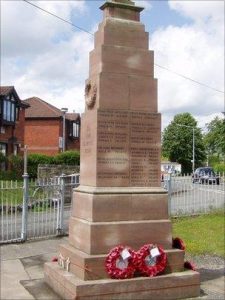
The Great War, 1914-1918
Edward John Adlington, Private, 46232, Labour Corps. Edward was the son of Joseph and Jane Adlington, of Broad Street, Presteigne. He worked as a gardener prior to attesting at Presteigne into the Labour Corps on 28 February 1916, and on 27 May 1916 married Mildred Legge at Kington. Edward appealed against being called up for military service, but failed in his tribunal, so on 27 February 1917 was mobilised. On 13 March 1917 Edward embarked for France to join the Infantry Labour Battalion of The King’s (Liverpool Regiment). He was transferred back to the 78th Company, Labour Corps at Ypres on 13 May 1917. Edward was wounded during the Third Battle of Ypres and evacuated to the 60th Field Ambulance, where he died of his wounds on 11 September 1917, aged 38. He is buried in Bleuet Farm Cemetery, near Ypres.
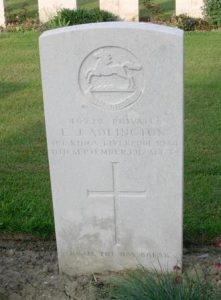
James Albert Booth, Corporal, 7751, Duke of Wellington’s (West Riding Regiment). James was the son of Charles and Eliza Booth, of West Wall, Presteigne. He was an army reservist, who had enlisted at Pontypridd on 22 October 1903 into the Pembroke RGA, a Territorial unit. By 1911 he was lodging with William and Eliza Preece, also from Presteigne, at 28, Park Terrace, Treforest, where he worked as a coal hewer. James re-enlisted at Neath into the West Riding Regiment on 5 August 1914 and landed at Le Havre, France with their 2nd Battalion on 27 August 1914. The battalion was attached to 13 Brigade, 5th Division and moved to the Belgian frontier, taking part in the Battle of Mons. It then retreated south with the rest of the BEF, fighting at Le Cateau, then down to the Marne where the German attack was halted. The Division then took part in the advance to the Aisne, before moving to Flanders, where it fought at the Battle of La Bassée, then at Messines in October 1914. It fought throughout the First Battle of Ypres, taking part in the capture of Hill 60. James was wounded at Ypres on 11 November and spent Christmas at home recovering. He re-joined his battalion in time to take part in Second Ypres in April 1915. On 4 January 1916 the 2nd West Ridings transferred to the 4th Division and moved to the Somme. The Division took part in the opening Battle of Albert and later in the offensive took part in the Battle of Le Transloy. The battle was launched on 1 October 1916 in co-ordination with the French to the south and raged on for over two weeks. James was killed in action near Le Transloy on 12 October 1916, aged 30. He is buried in Guards’ Cemetery, Lesbœufs, France. The son of his landlord, Harry Preece, of Presteigne, had been killed during the opening of the Somme offensive.
Osborne Aaron Bounds, Private, 201460, King’s Shropshire Light Infantry. Osborne was born in Porth, Rhondda, in 1895, the son of Aaron and Matilda Bounds. His father was from Knighton and by 1911 the family were residing at Willersley, Herefordshire, where Osborne worked as an estate carpenter with his father. Osborne enlisted into the King’s Shropshire Light Infantry at Presteigne on 30 January 1916. After training at Pembroke Dock, he was posted to France, joining the 1/4th Battalion, KSLI, following its return from service in the Far East. On 27 July 1917 the battalion re-embarked at Southampton and landed at Havre on 29 July 1917, joining 190 Brigade, 63rd (Royal Naval) Division, which was still at Arras. The division moved to Ypres soon afterwards in order to take part in the assault on Passchendaele Ridge, and then on 10 December the division entrained for the Cambrai sector, to take part in the battle that was still raging there and took up positions by Welch Ridge. The Division saw heavy fighting here before the Battle of Cambrai closed down, but remained in this sector over the coming months. On the morning of 21 March 1918, the Germans launched the first part of their Spring Offensive, on a front running south from Cambrai to the Somme, and the 4th KSLI was sent forward to assist the beleaguered troops in the front. The fighting over the coming days was so severe that Osborne is recorded by differing sources as having been killed on three separate dates: the 23rd, 25th and 26th March. His death was later officially recorded as having taken place near on 26 March 1918, when the 4th KSLI was in positions around Hébuterne. He was 22 years old and is buried in Grevillers British Cemetery, France.
Pryce Thomas Bowen, Private, 3796, Herefordshire Regiment. Pryce was the son of Thomas and Jane Bowen, of Warden Terrace, Presteigne. He worked as a waggoner prior to enlisting at Presteigne into the 3/1st Battalion, Herefordshire Regiment on 24 May 1915 and was posted to Park Hall Camp, Oswestry for his training. In January 1916 he took ill and was hospitalised, suffering from pain in the upper body and a fever. He was diagnosed as suffering from rheumatic fever and was discharged as physically unfit on 17 October 1916, returning home to Presteigne. Sadly, he died of heart failure at home on 20 December 1917, aged 22. He was buried with full military honours at Presteigne Cemetery.
Colwyn Frank Briggs, Private, 235272, Herefordshire Regiment. Colwyn was the son of Charles and Sarah Briggs, of High Street, Presteigne. He enlisted at Presteigne into the Herefordshire Regiment and after training was posted to France, joining the 1/1st Battalion, Herefordshire Regiment. The battalion had taken part in the arduous campaign in Palestine with the 53rd (Welsh) Division, but following the huge losses suffered by the British as a result of the three German Spring Offensives, was among a number of units withdrawn from Palestine. The 1/1st Herefords sailed from Palestine for Italy and then entrained at Taranto for the Western Front on 23 June 1918, reaching Proven, Belgium on 30 June and joining 102 Brigade, 34th Division at St. Jan Ter Biezen. The battalion then carried out some training before the division entrained for St. Omer, then moved to Longpont, near Soissons, on the Aisne. On 23 July 1918 the 1/1st Herefords took part in an attack against the Germans holding the line opposite, but found their advance was hampered by standing corn, which was hard to attack through. John was among a large number of casualties suffered during the abortive attack that day. He was 20 years old and is buried in Raperie British Cemetery, Villemontoire, Aisne, France.
Francis William Bursnell, Private, 10373, Prince of Wales’s (North Staffordshire Regiment). Francis was born at Ludlow on 28 October 1880, the son of John and Mary Anne Bursnell. He had enlisted into the 3rd Battalion, King’s Shropshire Light Infantry in 1899 and had served during the Boer War. Upon leaving the army Francis lived at Presteigne, but as an army reservist re-joined the colours following the outbreak of war, and joined the 7th Battalion, North Staffordshire Regiment. The battalion had been raised at Lichfield on 29 August 1914, joining 39 Brigade, 13th Division on Salisbury Plain. On 26 June 1915 the battalion embarked at Avonmouth and arrived at Mudros on 12 July. On the morning of 13 July, the battalion landed at V Beach, Gallipoli and bivouacked on Gully Beach before moving forwards into the firing lines that evening, relieving the 29th Division. Two weeks later the division returned to Mudros and on 7 August the 7th North Staffs landed at ANZAC Cove, to take part in the planned offensive. During the night the battalion marched up the steep slopes of Aghyl Dere and on the following morning, 8 August 1915, began to advance. The fighting during the day was chaotic, with many units getting lost, and many casualties were suffered as a result. Francis was 34 years old when he was killed during the attack that day. He is buried in 7th Field Ambulance Cemetery, Turkey.
Henry Richard Butcher, Private, 19567, King’s Shropshire Light Infantry. Henry was born in Linton, Herefordshire in 1880, the son of William and Eliza Butcher. On 7 May 1898 he enlisted into the King’s Shropshire Light Infantry and served during the Boer War. In 1908 he married Rosina Ellen Collins and after being discharged from the army on 6 October 1910 the couple set up home at Bell Cottage, Scottleton Street, Presteigne. Following the outbreak of war, he re-enlisted into the King’s Shropshire Light Infantry and was posted to France in 1916, joining the 1st Battalion, King’s Shropshire Light Infantry, which was attached to 16 Brigade, 6th Division. His wife moved back to her native London with their three surviving children (their second child, Frederick, had died in 1915). The Division moved to the Somme sector and took part in the Battles of Flers-Courcelette, Morval and Le Transloy from 15 September 1916. On 19 October 1916 the 1st KSLI was in reserve trenches to the north of Ginchy, provided carrying parties to the front line. Henry was killed at some time during the day. He was 36 years old, and is commemorated on the Thiepval Memorial, France. His wife Rosina never remarried and died in Croydon, Surrey in 1975.
Lewis Davies, Private, 16162, Kings Shropshire Light infantry. Lewis was the son of James and Ellen Davies, of Yew Tree Cottage, Coombes Moor, Presteigne. He lived at New House Farm, Upton Cressett, near Bridgenorth prior to the war, where he worked as a waggoner. Lewis enlisted at Hereford to enlist into the King’s Shropshire Light Infantry and embarked for France on 27 July 1915, joining the 1st Battalion, King’s Shropshire Light Infantry, which was attached to 16 Brigade, 6th Division. The battalion had just taken part in heavy fighting at Hooge the previous month, and was rebuilding before moving south to the Somme in 1916. Lewis was wounded on the Somme and was invalided back to Britain for treatment. He returned to France following his recovery and was posted to the 7th Battalion, King’s Shropshire Light Infantry, which was attached to 8 Brigade, 3rd Division. Lewis possibly fought at the Battle of Arras and the Battle of Passchendaele with the 7th KSLI, before becoming ill and returned home once more, being taken to hospital in Bristol for treatment after being diagnosed as suffering from colitis. He died of colitis at Bristol on 19 January 1918, aged 28 and his remains were brought home for burial in St. Mary’s Churchyard, Byton.
Horace Daniel Evans, Private, 32085, Gloucestershire Regiment. Horace was born at the Red Lion Inn, Whitton in 1897, the son of Walter and Louisa Evans. By 1911 the family was living at The Castle Hotel, Presteigne. Horace enlisted at London into the army and was posted to the 14th Battalion, Gloucestershire Regiment. The battalion was attached to 105 Brigade, 35th Division and landed at Le Havre on 30 January 1916, moving to the Somme sector. The Division took part in the Somme offensive that summer, but suffered so many casualties that by the end of the year, the Divisional commander reported that the Division was suffering from low physical and morale standards. Almost 3,000 men were thrown out of the division and posted to the Labour Corps and their places were filled with men from Yeomanry regiments. The Division then went back into the line, and followed the German Retreat to the Hindenburg Line in March 1917. Horace was wounded during the advance which followed and was evacuated to the Base Hospital at Rouen, where he died of his wounds on 29 March 1917, aged 19. He is buried in St. Sever Cemetery Extension, Rouen, France. One of his brothers, John Sidney Evans, was wounded and taken prisoner by the Germans during the war.
William Thomas Evans, Private, 204658, Middlesex Regiment. William was the son of George and Ann Evans, of Tinker’s Gate, Cascob, Presteigne. He worked as a waggoner at Paradise Farm, Presteigne prior to enlisting into the army at Presteigne on 9 February 1917. After training William embarked at Folkestone for Boulogne on 13 September 1917 and was posted to the 20th Battalion, Middlesex Regiment. The battalion was attached to 121 Brigade, 40th (Bantam) Division and had been in France since June 1916. William joined the battalion in the field on 22 September, in time to take part in his first major action, during the Battle of Cambrai. The division took part in heavy fighting at Bourlon Wood, which was assaulted with tank support on the morning of 23 November and over three days of heavy fighting suffered over 4,000 casualties. The Germans counter-attacked at Cambrai quickly and the offensive ended in a struggle to maintain the Flesquières Salient and by 7 December the British had retreated to their original lines. The 40th Division wintered in the Cambrai sector and on 14 February 1918 William was admitted to hospital after his health had begun to break down, and he was diagnosed as suffering from Impetigo. He was treated and had a brief rest before re-joining his battalion, but was unfortunately caught up in heavy fighting soon after, when the Germans launched their Spring Offensive on 21 March 1918. The division fought a desperate rear-guard action over the coming days before being evacuated from the front and moved to the Lys sector to rebuild. Unfortunately, the Germans launched the second phase of their offensive here on 9 April and the division again became caught up in desperate fighting. William was reported as missing on 11 April and was among a huge number of men taken prisoner by the Germans. He was taken to the POW camp at Limburg in Germany where he died of dysentery on 30 July 1918, aged 31. Oddly he is buried in Lille Southern Cemetery, France. There is no note of his grave being exhumed from Germany and re-buried in Lille, so did he die in Lille?
Thomas Frederick George, Private, 48823, Lancashire Fusiliers. Thomas was born in Leintwardine in about 1882, the son of John and Ruth George. By 1901 he was living at Presteigne and worked as a cattleman at Pentre Farm, then at Kinsham Farm. He married Alice Stephens, of Byton, in St. Mary’s Church on 18 February 1914. Thomas enlisted at Leominster into the army and was posted to the Middlesex Regiment. Upon being drafted to France he was transferred to the 10th Battalion, Lancashire Fusiliers, which was attached to 52 Brigade, 17th Division. He probably joined the battalion following the Somme offensive in the summer of 1916. He would then have taken part in the Battle of Arras in the spring of 1917. The Division then moved north to take part in the Battle of Passchendaele, before moving back to the Somme sector the following year, where it took part in the desperate fighting which resulted following the German Spring Offensive which was launched on 21 March 1918. The Division remained on the Somme sector over the summer and took part in the Battle of Amiens on 8 August 1918. The battle marked the turning point of the war and from then onwards the Allies began the advance towards the Hindenburg Line which would ultimately lead to victory. By 31 August the division was west of Le Transloy, and early on the following morning of 1 September 1918 attacked a German strong-point situated in the village cemetery. The attackers were bombarded with Blue Cross gas shells before being hit by machine-gun fire, and suffered heavily. Thomas was among the dead. He was 36 years old and is buried in Bancourt British Cemetery, France. His brother, John George, served with the Australian Infantry and was killed at Villers-Bretonneux on 25 April 1918.
Richmond Edward Ormond Lyttleton Green, Second Lieutenant, King’s Shropshire Light Infantry. Richmond was born at Llanfair Waterdine on 22 November 1895, the son of Frederick Lyttleton Green and Lucy Emma Green (nee Edwards). The family later resided at 7, Broad Street, Presteigne. He was educated at Shrewsbury School and at Rossall and had begun work as a Solicitor before the outbreak of war. He was commissioned into the King’s Shropshire Light Infantry on 14 September 1914 and was posted to the 6th Battalion, Kings Shropshire Light infantry, where he became Transport Officer. The battalion had formed at Shrewsbury in September 1914 and joined 60 Brigade, 20th (Light) Division at Aldershot. On 22 July 1915 Richmond landed at Boulogne with the battalion, which then moved to the Fleurbaix sector for trench familiarisation and training. When the Battle of Loos was launched on 25 September 1915 the Division fought a diversionary attack towards Fromelles. Later that year it moved north, to the Ypres sector. On 19 February 1916 Richmond was in charge of a working party near the canal bank when he was shot in the head and killed. The 20-year-old was buried in Essex Farm Cemetery, Belgium. His Commanding Officer wrote to his parents: ‘Always cheerful and never happier than when on especially dangerous work in ‘No Man’s Land.’ He was brave beyond words, and the life and soul of his comrades. We were all most proud of him.’
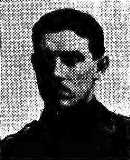
Edward Holl, Private, 653246, London Regiment. Edward was born in Aston-on-Clun in 1898, the son of Annie Holl, an unmarried Parlour Maid. He was raised by his grandparents, Robert and Hannah Holl, in Yarpole. By 1911 Hannah was widowed and had returned to her native Presteigne with her grandson, Edward. Edward enlisted at Wimbledon in October 1914 into the London Regiment and in 1916 was posted to France, joining the 21st Battalion, London Regiment (1st Surrey Rifles), which was attached to 142 Brigade, 47th Division. He joined the battalion at Lahoussoye on the Somme on 1 September 1916, where it was rebuilding following its efforts during the Battle of Flers-Courcelette, the first time that tanks were used in action. His battalion moved back into the line NE of Fricourt on the 14th and two weeks later took part in the Battle of Le Transloy, where the Division captured Eaucourt l’Abbe. Edward was killed during the assault on Eaucourt l’Abbe on 8 October 1916, aged 18. He is buried in Warlencourt British Cemetery, France.
Norman Menzies Hughes, Private, 56569, Royal Welsh Fusiliers. Norman was born in Shrewsbury on 26 February 1898, the son of Ernest Charles Hughes and Edith McMath Hughes. Upon leaving school he became a Clerk at the Presteigne branch of Barclays Bank and had made the town his home. He enlisted at Presteigne into the King’s Shropshire Light Infantry, but after being drafted to France towards the end of 1917 was transferred to the 14th Battalion, Royal Welsh Fusiliers. The battalion was attached to 113 Brigade, 38th (Welsh) Division and Norman would have joined the battalion at Ypres, where it had moved following its ordeals during the capture of Mametz Wood on the Somme in July 1916. He probably joined the battalion following its attack on the Pilckem Ridge on 31 July 1917, where it had suffered heavy casualties. The division had taken part in the opening offensive of the Third Battle of Ypres, or Passchendaele and had made a reputation for itself for its fine work capturing the Pilckem Ridge and advancing the line to the Steenbeek. It was withdrawn from Ypres on 11 September 1917 and moved to the Armentieres sector to rest and rebuild. Norman served with D Company, and was in their billet at Rue de la Dormiore on 29 December 1917, when a German artillery shell crashed into the building and exploded, killing seven men. Norman was 19 years old when he was killed in the explosion and is buried in Croix-du-Bac British Cemetery, Steenwerck, France.
William Herbert Johnson, Private, 1345, Herefordshire Regiment. William was the fourth of ten children of Tom and Sarah Ann Johnson, of 54, Hereford Street, Presteigne. His father died in 1910, and William began working as a railway carter to help support his family. He enlisted at Presteigne into the Herefordshire Regiment on 22 June 1913. The regiment was a Territorial unit, and William attended his first annual training camp in August 1913. Following the outbreak of war, he was embodied on 6 August 1914 and moved to Pembroke Dock with the 1st Battalion, Herefordshire Regiment. The battalion was attached to the 53rd (Welsh) Division and in December moved with the division to Bury St. Edmunds. Over the winter the Division trained hard in readiness to embark for overseas service, but the harsh, damp, climate took its toll on William’s health and he was diagnosed as having contracted tuberculosis. He was discharged from the regiment as medical unfit on 26 January 1915 and returned to Presteigne, where he died on 6 December 1915, aged 18. He is buried in Presteigne Cemetery.
John Stanley Joseph, Private, 44314, King’s Shropshire Light Infantry. John was the son of John and Annie Joseph, of Willey, Presteigne. He worked on his father’s farm prior to the war but was conscripted in 1916 and sent to join the 4th Battalion, King’s Shropshire Light Infantry at Pembroke Dock. He was confirmed on 14 July 1918 by the Bishop of St David’s at St Albans Church, Bush Camp, Pembroke Dock, but within months had taken ill and was sent home. John died of influenza and meningitis at Lower House, Presteigne on 19 November 1918. He was buried in the family plot at Lingen (St. Michael) Churchyard, Herefordshire. He is not commemorated by the CWGC.
David Lewis, Private, 17971, Kings Shropshire Light Infantry. David was born at Presteigne in 1885, the son of George and Hannah Lewis. By 1901 the family was living at 10, Market Street, Wrexham, where his father had gained work. By 1911 David was working as a labourer and living at Old Oak, Market Street, Knighton, while his father had retired and moved back to West Wall, Presteigne. David enlisted at Knighton into the King’s Shropshire Light Infantry on 17 May 1915 and was posted to the barracks at Shrewsbury. He was posted to the 5th Battalion, KSLI and landed in France on 5 October 1915, joining the battalion at Ypres, where it was attached to 42 Brigade, 14th (Light) Division. The battalion was recovering after a period of heavy fighting at Bellewaarde and at the end of October moved to billets at Houtkerque. By 18 November 1915 the battalion was back in the line at Ypres, beginning another tour of duty. During February 1916 the Division moved to the Arras sector and began rotating in the front line. During April 1916 the battalion was coming out of the trenches when David began feeling ill and fainted. He was taken to a nearby Field Ambulance where they staff picked up a high-pitched murmur in his heart, so David was hospitalised before returning to England. He was discharged as medically unfit on 13 September 1916 and returned to his father’s home at Presteigne. David died of kidney failure there on 9 August 1917, aged 34, and was buried in Presteigne Cemetery.
William John Lewis, Private, 54440, Machine Gun Corps. William, known as John, was born in Clunbury in 1897, the son of John Lewis and Mary Olivia Lewis (nee Pearce). The family had moved to Broad Street, Presteigne prior to the war and John enlisted there on 6 June 1916 into the Herefordshire Regiment. During his training he would have become a specialist machine-gunner, and was transferred to the Machine Gun Corps. William was posted to Egypt, where he joined the 18th Squadron, Machine Gun Corps. The Squadron was a mobile unit, attached to the 22nd Mounted Brigade of the Yeomanry Mounted Division. The Division took part in the Third Battle of Gaza, aiding in the capture of Jerusalem. During March 1918 the Division was re-organised and became the 1st Mounted Division, absorbing elements of the Indian Army. The Division then took part in operations in the Judean Hills and the Jordan Valley before the war came to an end. John took ill just after the Armistice and was taken to the 17th General Hospital at Alexandria, where he died of pneumonia on 26 November 1918, aged 21. He is buried in Alexandria (Hadra) War Memorial Cemetery, Egypt.
John Ernest Meredith, Private, 22381, King’s Shropshire Light Infantry. John was born in Beguildy in 1889, the son of William Ernest Meredith and Elizabeth Meredith (nee Davies). By 1911 his parents had moved to The Manse, Ackhill, Presteigne, while John worked as a shepherd at Yew Tree Farm, Presteigne prior to the war. He enlisted at Presteigne into the King’s Shropshire Light Infantry, and was posted to France in 1916, joining the 6th Battalion, King’s Shropshire Light Infantry, which was attached to 60 Brigade, 20th (Light) Division. He possibly arrived in France in time to take part in the Somme Offensive, where the Division fought in the Battles of Delville Wood, Guillemont, Flers-Courcelette, Morval and Le Transloy. The Division wintered on the Somme and took part in the advance to the Hindenburg Line in March 1917, before moving to the Ypres sector during the summer to take part in the Third Battle of Ypres. John was wounded at Ypres and was brought back to England via the chain of Casualty Clearing Stations and a Base Hospital in France, before arriving at Worcester Hospital. He died of wounds there on 16 October 1917, aged 28. His remains were brought home and he was buried in Ackhill Baptist Chapelyard, Presteigne.
Alfred Harbridge Millichamp, Company Sergeant Major, 6475, South Wales Borderers. Alfred was the son of Charles and Sarah Hannah Millichamp, of High Street, Presteigne. He enlisted into the South Wales Borderers as a young man and served during the Boer War with the 2nd Battalion, SWB. Alfred married Ada Maud Howse at Pewsey, Wiltshire on 2 December 1908, and by 1911 was back in South Africa with the battalion, in married quarters with Ada and their son, George Charles. By the time that was erupted, Alfred was in China with the 2nd SWB. The battalion took part in an assault on the German held port of Tsingtao in conjunction with Chinese troops, landing at Lao Shan Bay on 23 September 1914. On 4 December 1914 the battalion embarked at Hong Kong and landed at Plymouth on 12 January 1915, to join 87 Brigade, 29th Division at Rugby. On 17 March 1915 the Division embarked at Avonmouth for the Mediterranean and at dawn on 25 April 1915 the 2nd SWB landed at Morto Bay, Gallipoli from HMS Cornwallis and saw heavy fighting. The beaches were consolidated throughout the day, around De Totts Battery. The battalion then took up positions in trenches facing Achi Baba and on 8 May 1915 took part in a co-ordinated attack against the Turkish lines. The attack was held up almost immediately when it came under heavy Turkish machine-gun fire and the troops were forced to withdraw, after suffering heavy losses. Alfred was 33 years old when he was killed during the advance that day. He has no known grave and is commemorated on the Helles Memorial, Gallipoli. Two of his brothers also fell during the war.
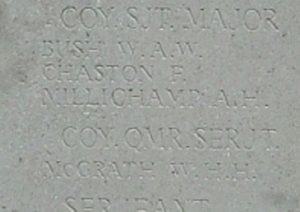
Henry Farmer Millichamp, Private, 1000827, Canadian Infantry. Henry was born on 14 May 1888, the son of Charles and Sarah Hannah Millichamp, of High Street, Presteigne. Henry trained as a printer and played football for Presteigne FC prior to deciding to emigrate to Canada and found work in a printer’s shop in Minnedosa, Manitoba. He enlisted at Minnedosa into the 226th Overseas Battalion, Canadian Infantry on 28 February 1916, stating that he had two years military service with the Herefordshire Territorials. The battalion sailed from Halifax, Canada for England aboard the SS Olympic on 13 December 1916, arriving on 26 December, when it moved to Salisbury Plain. On 31 May 1917 Henry embarked for France and joined the 78th Battalion, Canadian Infantry, which by then was in the Arras sector, attached to 12 Brigade, 4th Canadian Division, having just taken part in the capture of Vimy Ridge. Henry saw his first action during a series of engagements south of the Souchez River which led to the capture of Avion on 29 June, and then fought in the Battle of Hill 70 in August, before the Canadian Corps was moved north to Ypres, taking part in the Second Battle of Passchendaele from 26 October until 10 November. The Canadians did not take part in the fighting which followed the three German offensives in the Spring of 1918, but following the dramatic defeat of the Germans during the Battle of Villers-Bretonneux on 8 August 1918, the Canadians played a vital role in the great offensive which ultimately won the war. At the beginning of August 1918, the 78th Battalion, CEF was at Fampoux, and on the following day began to move to the southern Somme sector, to the area west of Amiens around Seux. The Canadian Corps then moved west, in preparation to take part in the Battle of Amiens, launching their attack at dawn on 8 August 1918 and advanced to the south of the Australians, towards the village of Hallu. Henry was killed in action near Hallu on 11 August 1918, aged 30. He has no known grave and is commemorated on the Vimy Memorial, France. Two of his brothers also fell during the war.
William George Millichamp, Corporal, 236594, King’s Shropshire Light Infantry. William was the son of Charles and Sarah Ann Millichamp, of High Street, Presteigne. He entered the Civil Service upon leaving school and moved to Islington. Following the outbreak of war, William enlisted at Hereford into the Herefordshire Regiment on 15 September 1914, but upon being drafted to France early in 1918 was posted to the 7th Battalion, King’s Shropshire Light Infantry, which was attached to 8 Brigade, 3rd Division. The Division had taken part in the Battle of Cambrai in November 1917, and they were still in the area during March 1918 when the German Spring Offensive swept through the British lines. The Division then took part in heavy fighting during the rear-guard actions which followed and was moved to Flanders to rebuild. However, the Germans switched the focus of their offensive to Flanders, and the Division was caught up in the worst of the fighting there. When the German offensive finally stalled, the Division was moved south to take part in the great British offensive, and from 21 August 1918 began their advance. On 2 September 1918 the Division attacked the high ground above Lagnicourt. The 7th KSLI was in the thick of the fighting and made a continuous advance of 4,000 yards, but by the time it had gained its objectives had suffered almost 250 men killed or wounded. William was one of the men killed that day, on 2 September 1918. He was 23 years old and is buried in Vaulx Hill Cemetery, France. Two of his brothers also fell during the war.
Allen Clarke Morgan, Lance Corporal, 136275, Machine Gun Corps. Allen was the son of Thomas and Ann Maria Morgan, of Old Turnpike Road Cottage, Byton. By 1911 he was living with his sister, Ellen, and her husband, William John Harris, at Ackland Road, Bridgend, where he worked for the Great Western Railway. Allen had moved with his job to Hereford in 1912, but by the time war erupted he was living at Newcastle-on-Tyne and enlisted there into the 19th Battalion, Northumberland Fusiliers. He was posted to France and joined the 49th Battalion, Machine Gun Corps, which was formed on 1 March 1918 from the MG Companies of the 49th (West Riding) Division. The Division took part in the heavy fighting on the Lys, following the second phase of the Germans offensive, which was launched on the Lys on 9 April 1918. After the tide of war had been turned, with the Allied successes on the Somme during August 1918, the Division took the offensive and took part in the resulting Pursuit to the Selle. Allen was killed in action during the advance, on 11 October 1918, aged 27. He is buried in Iwuy Communal Cemetery, France. His brother, James, also fell.
James Ambrose Morgan, Private, 266772, Monmouthshire Regiment. James was the son of Thomas and Ann Maria Morgan, of Old Turnpike Road Cottage, Byton. By 1911 he was living with his elder brother, William, and his family, at Ynyswen, Penycae, near Ystradgynlais, where he worked as an underground collier. James had returned to Byton by 1912 after gaining work as a gardener and married Margaret Hill McKenzie on 5 May 1912. James enlisted in the Monmouthshire Regiment at Leominster on 9 December 1915 and after training was placed on the reserve. He was mobilised on 8 June 1916 and posted to France on 10 June 1916, joining the 2nd Battalion, Monmouthshire Regiment. The battalion was attached to the 29th Division, as the Divisional Pioneers. James would have seen his first action during the Divisions attack on Y-Ravine, on the Somme, on 1 July 1916. The Division suffered terrible casualties that day and was pulled out from the line and moved to Ypres to rebuild, before moving back to the Somme and going back into action at Le Transloy some months later. The Division remained in the Somme sector over the winter, which proved to be one of the harshest on record. On 28 February 1917 James was at work digging trenches in newly gained ground near Sailly-Saillisel, when the Germans bombarded their positions. James was one of three men killed and thirteen wounded during the barrage. He was 31 years old and is buried in Assevillers New British Cemetery, France. His brother, Allen, was killed the following year.
Brian Percy Morris, Private, 344, Australian Machine Gun Corps. Brian was born in Hereford Street, Presteigne in 1898, the son of Henry Frederick Morris and Annie Mary Morris (nee Hancox). His parents had made the difficult decision to leave Wales to start a new life in Australia with their family, and on 20 June 1911 the family boarded the SS Commonwealth in London, bound for Melbourne. They set up home at Kywong, Yarram, South Gippsland, Victoria. Brian worked as a farm labourer prior to the war, and followed in his elder brother Harold’s footsteps, enlisting into the Australian Imperial Force at Melbourne on 20 June 1916. He joined the 4th Reinforcements for the 12th Australian Machine Gun Company and after training embarked at Melbourne aboard the SS Orontes on 18 August 1916. Brian disembarked at Plymouth on 2 October 1916 and spent the next few months in various Australian camps in England, at Park House, Grantham and Belton Park. On 17 March 1917 Brian embarked at Southampton for France and upon arrival joined the 21st Australian Machine Gun Company, which was attached to the 1st Australian Division. He joined the Division just after it had taken part in heavy fighting on the Hindenburg Line, following a German counter-attack. In May he saw his first major action, during the Second Battle of Bullecourt. The Division was then relieved and following a spell out of the line returned to the Ypres Salient, taking part in the Battle of the Menin Road in September and Broodeseinde in October. By the end of February 1918 Brian’s unit had moved into billets in tunnels in Hill 60. On 17 March 1918 he was admitted to the 1st Australian Field Ambulance after the area had been bombarded with gas shells, and was then transferred to the 14th General Hospital at Wimereux, where he died of gas poisoning on 19 March 1918, aged 19. He was buried by Reverend J. E. Adams at Wimereux Communal Cemetery, France. His brother, Harold Geoffrey Morris, serving with the 14th Battalion, AIF was by then a POW in Germany, while their youngest brother, Godfrey Eustace Morris, was killed whilst serving with the RAAF in 1942.
Ivor Owens, Private, 239043, Herefordshire Regiment. Ivor and his twin brother Howard were born on 7 May 1898, the sons of John Whittal Owens and Margaret Owens (nee Rogers), of Llanevan Farm, Llanfihangel Nant Melan. The brothers moved to Presteigne, where they were educated. Despite taking the case to a Military Appeals Court, Ivor was drafted into the Herefordshire Regiment in 1917 along with his brother Howard, and the twins were sent to Park Hall Camp at Oswestry for training. Within weeks, Howard contracted influenza and was hospitalised in Oswestry Military Hospital. As he was recovering, Ivor took ill and he sadly died in the hospital of influenza on 25 February 1917, aged just 18. Ivor’s remains were brought home for burial in St. Tegla’s Churchyard, Llandegley. His brother Howard later served in France, but survived the war.
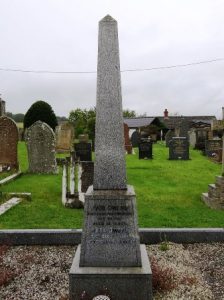
Charles Leonard Powell, Private, 85502, Durham Light Infantry. Charles was the son of George and Mary Ann Powell, of Quarry Field Cottage, Staunton on Arrow. Charles had qualified as an electrician before enlisting into the Inland Water Transport, Royal Engineers on 12 December 1915 and was posted to their depot at Sandwich for training. His electrical skills were marked as very superior on his service papers, but this was not to prevent him from being transferred to the infantry, as on 21 January 1917 he arrived in France and was transferred to the 1/8th Battalion, Durham Light Infantry. The battalion was attached to 151 Brigade, 50th (Northumbrian) Division, and was at Arras by the time that Charles arrived at the front. He then took part in his first major actions during the Arras Offensive of April 1917, where the division saw heavy fighting before being transferred to the Ypres sector, taking part in the Second Battle of Passchendaele. After wintering at Ypres, the Division transferred to positions near St. Quentin the following year, and became caught up in heavy fighting following the launch of the first stage of the German Spring Offensive on 21 March 1918. After suffering terrible casualties, the Division moved north to Flanders to rest and rebuild, but in April the Germans launched the second phase of their offensive, in Flanders, around the Lys, and the Division became caught up in terrible fighting once more. It was then withdrawn and sent to IX Corps, on the Aisne, believed to be a much quieter area. This was unfortunately not the case, as the Division was hit hard during the third, final, German offensive of 1918 and saw heavy fighting once more at the Battle of the Aisne. Charles was captured by the Germans here on 25 May 1918 and was taken to a camp in the Ardennes. After almost five months in captivity he took ill and died of colitis in a German hospital near Liart on 19 October 1918, aged 21. He was buried in the German cemetery at Liart, but after the war his body was exhumed by the IWGC and reburied in Sedan-Torcy French National Cemetery, France.
James Powell, Private, 2518, Lancashire Fusiliers. James was the son of Henry Powell, of Broad Street, Presteigne. He was living in Liverpool prior to the war, and enlisted at Salford into the 1/7th Battalion, Lancashire Fusiliers. The battalion was raised at Salford, attached to the Lancashire Fusiliers Brigade, East Lancs. Division. James did not embark for Egypt with the original battalion, as he married Margaret Victoria Bathgate at Liverpool early in 1915, prior to embarking for Gallipoli among a number of reinforcements for the battalion, which had landed at Cape Helles on 5 May 1915. James arrived at the Peninsula on 23 July 1915, by which time the division had been re-organised, and the 1/7th Lancashire Fusiliers was now attached to 12 Brigade, 42nd (East Lancs) Division. James did not survive long at Gallipoli, as he was killed in action there on 8 August 1915 during a counter-attack by the Turks on the battalion’s positions at the Redoubt Line. James was 33 years old when he fell that day. He has no known grave and is commemorated on the Helles Memorial, Gallipoli.
James George Powell, Private, 131408, Labour Corps. James was the son of Thomas and Mary Powell, of West Wall, Presteigne. James worked as a mason’s labourer prior to the war. He married Emily Brunt in 1913, and the couple set up home at Warden Terrace, Presteigne, where their two sons were born. James enlisted into the army at Shrewsbury on 7 June 1916, but was not mobilised until 20 March 1917, joining the 1st (Works) Battalion, The Kings (Liverpool) Regiment. He was not fit for overseas service so on 28 April 1917 was transferred to the Labour Corps. On 28 January 1918 he was transferred to the 420th Agricultural Company, Labour Corps, which was based near Wrexham and James worked there as a farm labourer. His health soon began to break down and James was diagnosed as having contracted tuberculosis, before being discharged as medically unfit on 19 June 1918. He returned home to Presteigne where he died of tuberculosis on 22 July 1918, aged 26. He was buried in Presteigne Cemetery.
John Thomas Powell, Lance Corporal, 27808, Border Regiment. John was the son of James and Harriett Powell, of 51, High Street, Presteigne. John worked as a Haulier with his father prior to enlisting at Presteigne into the Herefordshire Regiment on 8 February 1916. After training, he was posted to France in the summer of 1916 and transferred to the 11th Battalion, Border Regiment, known as The Lonsdale’s. The battalion was attached to 97 Brigade, 32nd Division, and was on the Somme, where it was rebuilding following heavy losses during their assault on Thiepval and Authille Woods at the beginning of the Somme offensive. John would have seen his first major action with the Lonsdale’s at the Battle of the Ancre and the resulting Operations on the Ancre. The Division remained in the Somme area over the winter, and in March 1917 followed the German Retreat to the Hindenburg Line. Their next major action was during the First Battle of Arras from April to May 1917. The Division was in the Ypres sector following the closure of the Passchendaele offensive, and on 1 December 1917 moved into the line from the area of Wurst Farm, in readiness for an attack the following morning. At 01.55 on 2 December 1917 the Lonsdale’s attacked German positions south of Westroosebeek, on the Passchendaele Ridge, and took all their objectives. John was killed in action during the mornings fighting. The 20-year-old has no known grave and is commemorated on the Tyne Cot Memorial, Belgium.
Walter Powell, Private, 285271, Welsh Regiment. Walter was the son of William and Priscilla Powell, of Titley, Herefordshire. By 1911 he was working as a Butchers Assistant at Presteigne and was lodging at Lilac Cottage with Alice Davies and her niece Helena Jane Abel. Walter married Helena in 1912, and their three sons were born at Lilac Cottage. Walter enlisted at Presteigne into the Herefordshire Regiment, and was posted to France in January 1917, where he transferred to the 6th Battalion, Welsh Regiment. Instead of being posted to the 6th Welsh, he joined the 10th Battalion, Welsh Regiment, which was attached to 114 Brigade, 38th (Welsh) Division. The Division had moved to positions on the Canal Bank at Boesinghe late in 1916 after its ordeals during the capture of Mametz Wood in July. It held the Canal Bank sector continually until launching its offensive against Pilckem Ridge on 31 July 1917, as part of the opening assault of the Battle of Passchendaele. The 10th Welsh launched their attack on the right of the Divisions front, alongside the 7th Battalion, Black Watch of the 51st (Highland) Division and successfully captured their objectives of Candle Trench and the Black Line. Walter had been badly wounded during the heavy fighting that morning and died later that day. The 30-year-old is buried in Bard Cottage Cemetery, Belgium.
Charles Henry Preece, Private, 20170, Devonshire Regiment. Charles was born at West Wall, Presteigne in 1893, the son of William Preece and Elizabeth Preece (nee Booth). By 1911 the family was residing at 28, Park Terrace, Treforest, where his father William worked as a timber man. Lodging with the family was another Presteigne man, James Booth, who would sadly also be killed during the war. Charles worked as a collier prior to enlisting at Pontypridd into the 3rd Battalion, Devonshire Regiment on 10 September 1914. He was discharged as no longer fit for war service a month later and returned to Pontypridd, marrying Annie Davies in 1915. There are no surviving records to state what his lack of fitness was, but Annie was a nurse at Penhaye Auxiliary Hospital, Llandrindod Wells, so Charles may have met her there. He swiftly re-joined the Devonshire Regiment and was posted to France early in 1916, joining the 2nd Battalion, Devonshire Regiment, which was attached to 23 Brigade, 8th Division. The Division took part in the opening assault of the Battle of the Somme, attacking between Ovillers and La Boiselle, but suffered terrible casualties. The 2nd Devon’s had suffered the loss of seven officers and 43 other ranks killed; six officers and 194 other ranks wounded; and three officers and 178 other ranks missing, almost half of the total battalion’s strength. Among those killed was Charles. The 22-year-old has no known grave and is commemorated on the Thiepval Memorial, France.
Albert Edward Probert, Private, 55502, Royal Welsh Fusiliers. Albert was Elsdon Green, Lyonshall, in 1890, the son of George and Frances Probert. His father died in 1898 and his mother moved the family to Nash Lime Works, near Presteigne. Albert worked as a Waggoner at Upper House Farm, Evenjobb prior to enlisting at New Radnor into the Montgomeryshire Yeomanry. He was posted to France in 1917, joining the 17th Battalion, Royal Welsh Fusiliers, which was at Ypres attached to 113 Brigade, 38th (Welsh) Division. The Division had moved to Ypres in the summer of 1916, to rebuild following its efforts in capturing Mametz Wood in July 1916. It held the Canal Bank sector of the line north of Ypres, at Boesinghe over the coming months, until taking part in the opening assault of the Third Battle of Ypres, storming the Pilckem Ridge. In September the Division was moved to the Armentieres sector to rest and rebuild and at the end of March 1918 was moved to positions north of Albert, on the Somme, to take up the line facing Thiepval Ridge. The 17th RWF spent the last week in May 1918 in reserve at Hérissart, training and moved back into the line in front of Engelbelmer on 5 June. After a week in the line the battalion moved back into Divisional Reserve at Forceville, where it provided carrying parties for the battalions in the front line. On 18 June 1918, Albert was among one of these working parties when it came under German artillery fire, which killed one man and wounded four others. Albert was one of the wounded. He was evacuated to the 3rd Casualty Clearing Station at Gézaincourt where he died of his wounds two days later, on 20 June 1918, aged 27. He is buried in Bagneux British Cemetery, Gézaincourt, France.
Richard Pugh, Private, R/106690, Royal Army Service Corps. Richard was born at Presteigne in 1886, the son of Richard and Annie Pugh. Prior to the war Richard worked as a Cattleman and a Waggoner for the Lewis family at Ashley Farm, Roddhurst. He enlisted into the Army Remount Service at Knighton on 27 April 1915 and was posted to the Depot at Ormskirk. He remained on home service until 26 September 1916 when he embarked for France aboard the SS Princess Victoria, and upon arrival was posted to No. 2 Base Remount Depot. He then transferred to the Army Service Corps and served in France until after the Armistice, when he came home for two weeks leave. Richard was two days late returning from leave, getting back to his unit in France on 26 December 1918, and was admonished for his absence. He remained in France, nod doubt working on the sale of the many thousands of horses which had been used by the army, and sadly took ill and died at the 40th Stationary Hospital at Harfleur of pneumonia on 24 February 1919, aged 33. He is buried in Ste. Marie Cemetery, Le Havre, France.
William Arthur Reese, Private, 52860, Cheshire Regiment. William was born at Lea Hall Cottage, Llangunllo in 1896, the son of William and Eliza Reese. The family later moved to The Orls, Rhoddhurst, Presteigne. William worked as a cowman at Stanbatch prior to the war and enlisted at Shrewsbury into the Shropshire Yeomanry on 9 September 1915. On 11 August 1916 he was posted to the Infantry Base Depot in France and from there was posted to the 13th Battalion, Cheshire Regiment a week later. The battalion was attached to 74 Brigade, 25th Division and had seen heavy casualties during the early phase of the Somme offensive. Following the closure of the Somme battles, the Division moved to Ploegsteert and held the line for the months leading up the Battle of Messines in June 1917. William was wounded at Messines, receiving gunshot wounds to his right leg and foot, and was evacuated to the 14th General Hospital, Wimereux. He was then evacuated to England aboard the Hospital Ship St. Andrew and was sent to the Italian War Hospital in London on 10 June. By now his leg had become gangrenous and he spent five months in the hospital, before being sent to Baschurch Special Surgical Hospital, then to Shavington Auxiliary Military Hospital, Market Drayton. His health was now deteriorating quickly and he was diagnosed as suffering from meningitis before being sent to Prees Heath Military Hospital, where he died of a combination of his wounds and ailments on 8 January 1919, aged 22. His remains were brought home for burial in Presteigne Cemetery. He is also commemorated on the Rhayader War Memorial.
Arthur Saunders, Private, 10385, King’s Shropshire Light Infantry. Arthur was born as Arthur Wall, in St. John’s, Worcester in 1897. He was fostered by Arthur Richard Saunders and Anne Saunders (nee Cooke), who moved to Church Street, Presteigne prior to 1901. Arthur enlisted at Hereford into the King’s Shropshire Light Infantry prior to the war and was a regular soldier. The 1st KSLI was attached to 16 Brigade, 6th Division and was recalled to England, prior to landing at St. Nazaire on 10 September 1914 and moved to the Aisne to reinforce the hard-pressed BEF. Arthur was posted to France on 12 November 1914, among a number of re-enforcements to the 1st KSLI. He fought with the battalion until being forced to return home wounded, after being shot in the foot and, upon his return, was transferred to the 5th KSLI, which had landed in France on 20 May 1915, attached to 42 Brigade, 14th (Light) Division. He joined his new battalion at Ypres prior to the opening of the Battle of Loos, further to the south, on 25 September 1915. On that same day, as a diversionary tactic to draw German attention away from Loos, the 14th Division was tasked with making an attack at Ypres, with 42 Brigade being ordered to attack the German held Bellewaarde. The 5th KSLI had moved into Railway Wood on the night of 23/24 September in readiness to launch their assault at 4.20 on the morning of 25 September 1915. Unfortunately, the battalions on their flanks became held up and the 5th KSLI were forced to withdraw under heavy shellfire. Over 400 casualties had been suffered by the battalion during the day, among them Arthur, who had been killed in action. The 18-year-old has no known grave and is commemorated on the Menin Gate Memorial, Ypres.
Thomas James Smallman, Private, 81812, Canadian Infantry. Thomas was born at Presteigne on 29 July 1895, the son of James Smallman and Martha Emma Smallman (nee Evans). The family emigrated to Canada prior to the war, embarking at Liverpool aboard the SS Lake Champlain for St. John, New Brunswick on 30 March 1911 and set up home at Glencairn, Manitoba. Thomas worked as a Motorman prior to enlisting at Winnipeg into the Canadian Transport Section on 29 December 1914. He was then posted to the 32nd Battalion, Canadian Infantry and embarked at Halifax for England aboard the SS Vaderland on 23 February 1915. Thomas embarked for France from England on 5 May 1915 and was taken on strength of the 2nd Battalion, CEF. He served with the battalion at Ypres for almost seven months before being transferred to the 1st Battalion, Canadian Mounted Rifles at his own request, because his father James was serving as a Sergeant with the battalion. The battalion was attached to the 3rd Canadian Division. On 2 June 1916 the 1st Canadian Mounted Rifles and the 4th Canadian Mounted Rifles were holding the front south of Ypres, when the Germans launched their assault, which became known as the Battle of Mount Sorrel. The line was over-run by the Germans and the 1st Canadian Mounted Rifles suffered the loss of 80 percent of its men. Thomas was reported as being missing in action at some time between 2 and 5 June 1916, but following a court on enquiry was posted as officially having been killed on 5 June 1916. The 20-year-old has no known grave and is commemorated on the Menin Gate Memorial, Ypres. His brother William also fell with the CEF.
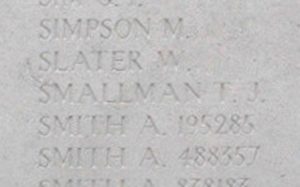
William Smallman, Private, 71955, Canadian Infantry. William was born at Presteigne on 20 May 1892, the son of James Smallman and Martha Emma Smallman (nee Evans). The family emigrated to Canada prior to the war, embarking at Liverpool aboard the SS Lake Champlain for St. John, New Brunswick on 30 March 1911 and set up home at Glencairn, Manitoba. William worked as a labourer prior to enlisting at Brandon into the 27th Battalion, Canadian Infantry on 26 October 1914. He embarked at Quebec with the battalion aboard the SS Carpathia on 17 May 1915. The battalion was attached to the 2nd Canadian Division and arrived in France in September 1915, forming the Canadian Corps with the 1st Canadian Division. William was hospitalised on 8 March 1916 after contracting rubella, and spent eleven days in hospital before being discharged to duty. He re-joined the battalion in time to take part in heavy fighting at the St. Eloi Craters from 27 March to 16 April, and then at the Battle of Mount Sorrel from 2 to 13 June, the same action that his brother Thomas was killed in. William suffered a gunshot wound to his arm at Mount Sorrel on 10 June and was hospitalised at No 4 General Hospital, Dannes, Camiers. He was posted to the Depot at Étaples after recovering and re-joined the battalion on 3 October. He would have then taken part in the Battles of Le Transloy and of the Ancre, before the Canadian Corps moved north to the Arras sector by the end of 1916. By 1 January 1917 the 27th Battalion, CEF was in Ablain St. Nazaire, counting the cost of the men who had been lost in 1916, almost 1,200 in total. On 3 January the battalion relieved the 29th Battalion in the front line in Souchez. For the next two days the battalion came under intermittent fire from a German Minenwerfer. William was killed by this minenwerfer on 5 January 1917, aged 24. He is buried in Bois-De-Noulette British Cemetery, Aix-Noulette, France.
Henry Taylor, Private, 5393, King’s Shropshire Light Infantry. Henry was born at Old Shildon, Durham in 1874, the son of Henry and Ellen Taylor. By 1891 his mother had been widowed and re-married John Williams, and the family were living at Hereford Street, Presteigne. In 1901 Henry married Jane Vaughan at Presteigne, and the couple had two sons in the coming years. Henry was a special reservist and re-enlisted at Hereford into the King’s Shropshire Light Infantry following the outbreak of war. On 18 February 1915 he landed in France and joined the 2nd Battalion, KSLI, which was attached to 80 Brigade, 27th Division. Henry joined the battalion at Dickebusch, near Ypres, on 22 February, as part of a draft of 253 men. On 1 March 1915 the 2nd KSLI moved into the trenches at St. Eloi, relieving the 4th Rifle Brigade and beginning a tour of duty in the front line. On the following day, 2 March 1915, Henry and one other man from the battalion were killed by snipers in the trenches. The 40-year-old Henry has no known grave and is commemorated on the Menin Gate Memorial, Ypres.
John Thomas Taylor, Private, 2315, Herefordshire Regiment. John was born at Broad Heath, Presteigne in 1896, the son of Edwin Taylor and Mary Taylor (nee Rees). His mother died the following year and his father remarried Alice Sarah Page in 1900. John worked as a farm hand for his father prior to enlisting at Hereford into the 1/1st Battalion, Herefordshire Regiment, and served with D Company. The battalion was attached to 158 Brigade, 53rd (Welsh) Division and sailed from Devonport in July 1915, arriving at Mudros on 5 August 1915. From here the Division moved to Gallipoli, landing at ‘A’ Beach, Suvla on 9 August 1915. The various units of the Division advanced up the slopes of Achi Baba with scarcely any maps and no knowledge of the terrain and immediately became caught up in heavy fighting. John was wounded at Suvla at some time after the landing and was evacuated by Hospital Ship to Malta, where he died of his wounds on 2 September 1915, aged 19. He is buried in Pieta Military Cemetery, Malta.
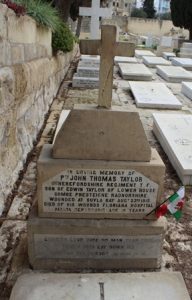
Henry Turner, Private, 27824, Border Regiment. Henry was born in Cascob in 1890, the son of John and Ann Turner. The family moved to Scottleton Street, Presteigne by 1897. Henry worked as a Waggoner for William Thomas at Stocken Farm, Norton prior to enlisting at Hereford into the 1st Battalion, Herefordshire Regiment. He was then transferred to the 3rd Battalion, KSLI, before being posted to France in 1916, joining the 11th Battalion, Border Regiment, known as The Lonsdale’s. The battalion was attached to 97 Brigade, 32nd Division, and was on the Somme, where it was rebuilding following heavy losses during their assault on Thiepval and Authille Woods at the beginning of the Somme offensive. John would have seen his first major action with the Lonsdale’s at the Battle of the Ancre and the resulting Operations on the Ancre. The Division remained in the Somme area over the winter, and in March 1917 followed the German Retreat to the Hindenburg Line. Their next major action was during the First Battle of Arras from April to May 1917. Henry was taken prisoner at some time during the Battle of Arras and was imprisoned in Germany. He was released after the Armistice, but his health had deteriorated and he died of influenza at the 35th General Hospital, Calais on 22 December 1918, aged 28. He is buried in Les Baraques Military Cemetery, Sangatte, France. His brother, William, was killed at Ypres the previous year.
William Turner, Gunner, W/3428, Royal Field Artillery. William was the son of John and Ann Turner, of Scottleton Street, Presteigne. He enlisted at Aberystwyth into the Welsh Divisional Royal Field Artillery. The Division later became re-numbered as the 38th (Welsh) Division and trained in North Wales before moving to Salisbury Plain in the summer of 1915. William was by now serving with ‘B’ Battery, 119th Army Brigade, RFA in the 38th (Welsh) Division, and he landed in France with the Brigade on 23 December 1915. The Divisional Artillery then moved to the Nursery Sector at Fleurbaix to catch up with the rest of the Division. Over the coming months the Division remained in Flanders, spending time at Cuinchy before being transferred to the Somme, and began to move south in June 1916. From 7 July 1916 the Division began its assault on Mametz Wood, and following its capture was moved first to Hébuterne and then to positions north of Ypres, along the Canal Bank at Boesinghe. The Division was to remain here until launching its offensive on the Pilckem Ridge on 31 July 1917, before taking part in the advance on Langemarck. William was killed in action here on 7 August 1917, aged 19. He is buried in Oak Dump Cemetery, Belgium. His brother, Henry, died of influenza in France the following year.
Robert Vaughan, Private, 6250, King’s Shropshire Light Infantry. Robert was born in Presteigne in 1876, the son of Elizabeth Vaughan. He had enlisted into the King’s Shropshire Light Infantry on 29 November 1899 and on 21 February 1901 was posted as a deserter from the 2nd KSLI barracks at Tipperary. He must have returned to the colours at some time, as when war broke out, he was a reservist and re-joined his old regiment at Shrewsbury. He landed in France on 8 April 1915, joining the 1st Battalion, KSLI, which was attached to 16 Brigade, 6th Division at Armentieres. The Division was holding a sector of the line to the SE of the town, and enjoying a relatively peaceful spell, apart from sporadic shelling. At dawn on 6 May 1915 Robert was in the trenches here with the battalion when the line came under fire by a stray shell from a British Howitzer, wounding five men. Robert was killed in action during the day. The 38-year-old is buried in Y Farm Military Cemetery, Bois-Grenier, France. He is a new addition to the Presteigne War Memorial, his name only being added in recent years.
George Heber Watkins, Private, 24987, Lancashire Fusiliers. George was born at Discoyd in 1890, the son of George and Mary Watkins. The family later resided at Broad Street, Presteigne. He worked as a Grocers Assistant prior to enlisting at Knighton into the Herefordshire Regiment. After completing his training, George was posted to France, where he was transferred to the 12th Battalion, Lancashire Fusiliers. The battalion had landed in France on 5 September 1915 attached to 65 Brigade, 22nd Division and in November 1915 the entire Division had moved to Salonika. George would have joined the battalion at some time in 1916. The Division fought in several large-scale battles during 1916 and 1917, with no real gain, as the Bulgarian troops facing them proved formidable foes. The campaign then bogged down into trench warfare, which saw more men invalided with sickness than wounds. George was attached to the 65th Trench Mortar Battery at some time after reaching the front. He was killed in action on 13 January 1918, aged 27, and is buried in Karasouli Military Cemetery, Greece.
Ernest John Webb, Driver, T3/028078, Royal Army Service Corps. Ernest was born at Heyhope, Knighton on 10 May 1889, the son of William Webb and Naomi Webb (nee Griffiths). He was educated at Heyhope School before becoming a Carpenter and by 1911 the family had moved to the Colony, Stonewall Hill, Norton. Ernest enlisted at Shrewsbury into the Army Service Corps on 7 November 1914 and was posted to France on 8 September 1915, where he became attached to the Royal Army Medical Corps. On 20 November 1917 he was with a group of men watering horses at Hersin when the Germans began shelling the area and a shell exploded over the men, killing them all. Ernest was 28 years old when he was killed that day, and is buried in Hersin Communal Cemetery Extension, France. He is also commemorated on the Norton War Memorial.
World War Two, 1939-1945
Godfrey Stuart Croft, Trooper, 7889720, Royal Armoured Corps. Godfrey was born in 1920, the son of Major Rodolphus Croft, and of Mary Elizabeth Croft (nee Wozencroft), of Belmont House, Presteigne. He enlisted into the 5th Royal Tank Regiment, Royal Armoured Corps following the outbreak of war. The Regiment served with the BEF in France until the survivors were evacuated from Dunkirk in 1940. After the evacuation it was re-equipped and then sailed to the Middle East as part of the 3rd Armoured Brigade, 1st Armoured Division. When Rommel counter-attacked in April 1941 it was part of 3rd Armoured Brigade and along with 3rd Hussars and 6th RTR it fell back on Tobruk. There it formed part of the Tobruk garrison until it embarking on 14 April 1941 for Egypt. After a re-fit it joined 4th Armoured Brigade and took part in the Battleaxe battles of November 1941 and the Gazala battles of May and June 1942, withdrawing with the rest of the 8th Army to El Alamein. Godfrey was killed at Gazala on 29 May 1942, aged 22. He has no known grave and is commemorated on the Alamein Memorial, Egypt. He is also commemorated along with his father and brother on a memorial in St. Peter’s Church, Evenjobb.
Rodolphus Croft, Flying Officer, 82776, Royal Air Force. Rodolphus was born at St. Owens, Hertfordshire on 4 September 1881, the son of Arthur and Martha Ellen Croft. He had enlisted into the King’s Shropshire Light Infantry prior to the Great War, giving his home address as Thorne, Presteigne, and married Mary Elizabeth Wozencroft in 1911. By 1914 was serving as Regimental Sergeant Major with the 1st KSLI. He was discharged to a commission in the West African Regiment on 29 August 1915 and by the end of the war had been promoted to Major. He returned to the family home at Presteigne after the war. On 28 June 1940 he was granted a commission as Pilot Officer with the RAF for the duration of the war. Flying Officer Rodolphus Croft relinquished his commission due to ill health on 3 June 1942 and returned home to Presteigne, where he died on 5 April 1944, aged 62. Little else is known of his service, as he is not commemorated as a casualty by the CWGC. He is also commemorated along with his two sons, who fell during WW2, on a memorial inside St. Peter’s Church, Evenjobb.
Roger Malcolm Croft, Serjeant, 4929130, Army Air Corps. Roger was born in 1923, the son of Major Rodolphus Croft, and of Mary Elizabeth Croft (nee Wozencroft), of Belmont House, Presteigne. He enlisted into the army after the outbreak of war. His original unit is not currently known, but on 5 September 1940 volunteers from No 2 Commando were selected for pilot training and attached to RAF Army Cooperation Squadrons. Combat gliders were still under development, so the pilots trained under the existing RAF elementary flying training regime in powered aircraft before converting to gliders. When the Army Air Corps was formed on 21 December 1940, the Glider Pilot Regiment was included within it. The first deployment for the Regiment came in North Africa, and then at Sicily, during Operation Husky. The Regiment returned to England to prepare for the invasion of Normandy, famously playing an important role in the capture and holding of Pegasus Bridge and the capture of the Merville Battery. Their next major action was at Operation Market Garden, an audacious plan to seize the Rhine crossing at Arnhem. The air element of Operation Market Garden was code-named ‘Market’ and the first lift took off from air bases in England on 09.45 onwards on Sunday 17 September 1944. The gliders were to land in a large open area at Oosterbeek, while the paratroopers of the 1st Airborne Division would also land at Oosterbeek. Roger was the Co-Pilot of Horsa Cn. 883, of B Squadron, in the 1st Wing, carrying men of the 1st Airlanding Light Regiment. There are varying reports of his death at Arnhem. One report was that he was killed when his glider crashed upon landing on the 17th, another that he died of wounds suffered the following day, whilst another theory is that he died on the 19th, as he was originally buried in the garden of the Ter Horst family, Benedendorpsweg, Oosterbeek. Nevertheless, the official date given for his death was 18 September 1944. The 20-year-old is buried in Arnhem Oosterbeek War Cemetery, Netherlands. He is also commemorated along with his father and brother on a memorial in St. Peter’s Church, Evenjobb.
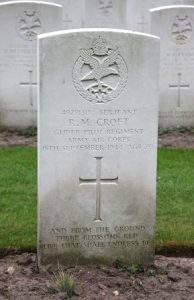
William James Jones, Private, 4105451, The Herefordshire Regiment. William was the son of William Jones and Sarah Jones (nee Whittingham) of Scottleton Street, Presteigne. He married Ethel Lilian Thomas, of Temple Buildings, Broad Street, Presteigne, in 1941. William enlisted into the 1st Battalion, Herefordshire Regiment. The battalion was attached to 159 (Welsh Border) Brigade, 53rd (Welsh) Division, and was mobilised on 2 Sept 1939. The battalion moved with the Brigade to Penally Camp, Tenby, but in April 1940 the Division moved to Northern Ireland. In May 1942, 159 Brigade joined 29 Armoured Brigade, 11th Armoured Division, under Major General Percy Hobart. It remained on home service until 13 June 1944 when the 1st Herefords landed with the Division on the Normandy beaches. The Division then took part in the push to break-out of the Normandy beach-head over the coming weeks, taking part in Operation Epsom then Operation Goodwood in July. Goodwood was launched on 18 July 1944, with the objective of capturing the rest of Caen and the Bourguébus Ridge beyond. William was killed on the first day of the operation, on 18 July 1944, aged 26. He is buried in Ranville War Cemetery, Calvados, France.
William Wesley Jones, Corporal 4198970, Royal Welch Fusiliers. William was born on 26 April 1918, the son of William Thomas Jones and Eliza Anne Jones (nee Davies), of Presteigne. He enlisted into the 1st Battalion, Royal Welch Fusiliers following the outbreak of war. The battalion had been in France with the BEF in 1940 and was evacuated from Dunkirk. After two years on home service it embarked with the 2nd Division for India, to take part in the campaign against the Japanese, moving into Burma upon its arrival. William was killed on 18 March 1944, probably during the heavy fighting which followed the Japanese offensive of 1944, when they crossed the Chindwin River and advanced towards Kohima. He was 24 years old and is buried in Taukkyan War Cemetery, Myanmar.
George William Lello, Driver, T/231558 Royal Army Service Corps. George was born at Bicton, Clun on 24 February 1907, the son of William James Lello and Rosanna Lello. He lodged at 6, Church Street, Presteigne and worked as a grocer’s van driver prior to the war. He enlisted into the Royal Army Service Corps and was posted to North Africa. George was most probably a prisoner of war, as he died in Italy on 9 March 1943, aged 35. He is buried in Milan War Cemetery Italy.
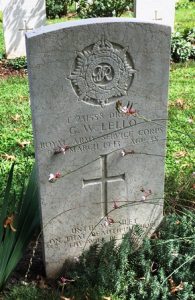
William Lewis, Fusilier, 14589030, Royal Welch Fusiliers. William was the son of William Lewis and Emily Lewis (nee Brunt, formerly Powell), of Presteigne. His mother had lost her first husband, James George Powell, during WW1 and had married William in 1920. William enlisted into the 6th Battalion, Royal Welch Fusiliers. The battalion was attached to 158 Brigade, 53rd (Welsh) Division and spent much of the war on home service, before landing in Normandy at the end of June 1944. The Division saw heavy fighting during the break-out from Normandy, especially at Hill 112, where it suffered heavy casualties. Almost two weeks later the Division became caught up in heavy fighting in the Falaise Pocket, in the countryside known as The Bocage. William was killed in the Bocage on 16 August 1944, aged 19. He is buried in Les Loges-Saulces Churchyard, Calvados, France.
William Thomas Lewis, Private, 4040785, The Herefordshire Regiment. William was born on 6 July 1913, the son of George Ernest Lewis and Rebecca Lewis (nee Bailey) of Cedarwood, Church Street, Presteigne. William enlisted into the 1st Battalion, Herefordshire Regiment. The battalion was attached to 159 (Welsh Border) Brigade, 53rd (Welsh) Division, and was mobilised on 2 Sept 1939. The battalion moved with the Brigade to Penally Camp, Tenby, but in April 1940 the Division moved to Northern Ireland. In May 1942, 159 Brigade joined 29 Armoured Brigade, 11th Armoured Division, under Major General Percy Hobart. It remained on home service until 13 June 1944 when the 1st Herefords landed with the Division on the Normandy beaches. The Division then took part in the push to break-out of the Normandy beach-head over the coming weeks, taking part in Operation Epsom then Operation Goodwood in July. The Division was then moved west, to take part in Operation Bluecoat. From 5 August, the Division worked with the Guards Armoured Division and 15th (Scottish) Infantry Division to push back a counter-attack of the 9th SS Panzer Division. William was killed on 15 August 1944, during the drive east. He was 31 years old and is buried in Banneville-La-Campagne War Cemetery, France.
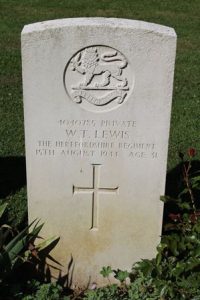
Godfrey Eustace Morris, Corporal, 12205, Royal Australian Air Force. Godfrey was born at Presteigne on 13 May 1908, the son of Henry Frederick Morris and Annie Mary Morris (nee Hancox). His parents had made the difficult decision to leave Wales to start a new life in Australia with their family, and on 20 June 1911 the family boarded the SS Commonwealth in London, bound for Melbourne. They set up home at Kywong, Yarram, South Gippsland, Victoria. Godfrey had married prior to the war, and lived with his wife, Marie Eileen Morris, at Nankeen, NSW. He was a motor mechanic prior to enlisted into the Royal Australian Air Force on 12 February 1940 and trained as a flight rigger at Richmond before being posted to Camden, NSW. On 11 July 1942 Godfrey was among a party of five men who attempted to free some horses which had become cut off by flood water behind the grandstand at Tamworth Racecourse. The flow of water was too strong and Godfrey and three other men were swept away. The other men managed to swim to safety but Godfrey cramped up and drowned. His body was found three days later on the banks of the Peel River. Godfrey was 34 years old when he drowned that day, and is buried in Tamworth General Cemetery, NSW. He is not commemorated on the Presteigne War Memorial, although his brother, Brian Percy Morris, who fell during WW1, is.
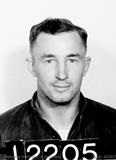
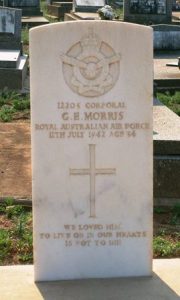
Richard John Francis Onslow, MVO, DSC, MiD, Captain, Royal Navy. Richard was born at Woolston, Hampshire on 29 March 1896, the son of Reverend Matthew Richard Septimus Onslow, a former Royal Naval Chaplain, and Mrs Fanny Harriet Onslow (nee Green). By 1901 his father had become Vicar of Bedstone, and the family was living at Bedstone Rectory. Richard enlisted into the Royal Navy on 13 September 1913, and was awarded the Distinguished Service Cross in 1918. He continued to serve in the Royal Navy between the wars and was created a Member of the Victorian Order (MVO) in 1937. He married Jessie Violet Betty Gillam in 1939, giving his address as Monaghty, Llangunllo. By then he was the Commanding Officer of the Light Cruiser HMS Coventry. Obviously a highly talented and respected officer, on 7 May 1940 he was given command of the Aircraft Carrier HMS Hermes. His first act was to participate in the blockade of Dakar, and the attempt to sink the French battleship Richelieu. While returning from this mission, Hermes rammed a British armed merchant cruiser in a storm and required several months of repairs in South Africa, before resuming work in the South Atlantic and the Indian Ocean. During February 1941, Hermes supported Commonwealth forces in Italian Somaliland and then in the Persian Gulf, before being sent to the Indian Ocean, enjoying a refit before joining the Eastern Fleet in Ceylon in February 1942. Hermes was berthed in Trincomalee on 8 April when a warning of a Japanese raid was received, and she sailed that day for the Maldives with no aircraft on board. On 9 April 1942 Hermes was spotted by a Japanese scout aircraft which reported her position and she was attacked and sunk by a large force of Japanese dive bombers shortly afterwards, going down with the loss of 307 men, including her Captain, Richard Onslow. Richard was 46 years old when he was killed that day, and is commemorated on the Plymouth Naval Memorial, Devon.
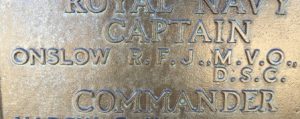
Clifford Price, Lance Corporal, 14589081, Royal Welch Fusiliers. Clifford was the son of Joseph Price and Ada Price (nee Thornton), of 2, Lower House Cottages, Broadheath Road, Presteigne. He enlisted into the Royal Welch Fusiliers and married Evelyn Margaret Price, of Byton, in 1943 whilst on leave from the army. Clifford was posted to the 4th Battalion, Royal Welch Fusiliers, which was attached to 158 Brigade, 53rd (Welsh) Division. The Division embarked for Normandy at the end of June 1944 and took part in the drive to break out from the beach-head. Following the break-out the Division took part in the drive north through Belgium and Holland into Germany over the coming months, taking part in Operation Market Garden and the Battle of the Bulge. By February 1945 the Division was advancing to the Rhine and took part in heavy fighting around the Reichswald Forest. On 16 February 1945, Lieut-Colonel J. M. Hanmer, Commanding the 4th RWF sent out a patrol to the East of the Reichswald and South of the Cleve State Forest. The patrol was pinned down by heavy fire in open ground and suffered casualties, but the German artillery was spotted and destroyed by counter-fire. Clifford was killed in action that day. He was 20 years old and is buried in Reichswald Forest War Cemetery, Germany.
Garfield Rees, Sergeant, 923347, Royal Artillery. Garfield was the son of Pryce Rees and Susannah Rees (nee Breeze), of The Croft, Walton. He married Koreen Jane Morris of Penlan, Pilleth, Whitton, in 1942. Garfield had enlisted into the Royal Artillery in 1939 and was posted to the 18th Medium Regiment, Royal Artillery, which was a TA unit that was moved to North Africa in 1943, before being transferred to Italy to take part in the campaign to wrestle the country from the Germans. Garfield was killed in Italy on 10 October 1944, aged 44, after the breaking of the formidable Gothic Line and the capture of Pisa. He is buried in Castiglione South African Cemetery, Bologna, Italy.
Thomas Frederick Rumsey, Sergeant, 637019, Royal Air Force. Thomas was the son of Percy Cecil Rumsey and Anne Rumsey (nee Powell), of 1, Howard Cottages, High Street, Presteigne. He enlisted into the Royal Air Force and was posted to India. Little else can be presently traced of his military service but he died in India on 14 October 1942, aged 27 and is buried in Delhi War Cemetery, India.
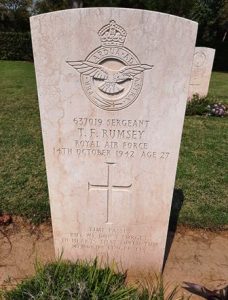
William Herbert Taylor, Sergeant, 924105, Royal Artillery. William was the son of George Taylor and Ethel Taylor (nee Venables) of 13 Church Street, Presteigne, Radnorshire. He enlisted into the Royal Artillery after the outbreak of war and whilst based in the Abergavenny area, married Sylvia Charlotte Price, in 1942. William served with the 133rd Field Regiment, Royal Artillery, which was a TA unit, attached to the 53rd (Welsh) Division. The Division embarked for Normandy at the end of June 1944 and took part in the drive to break out from the beach-head. Following the break-out the Division took part in the drive north through Belgium and Holland into Germany over the coming months, taking part in Operation Market Garden and the Battle of the Bulge. William was killed in Belgium on 16 December 1944, aged 24. He is buried in Schoonselhof Cemetery, Antwerp, Belgium.
Robert Thompson, Captain, 247093, Coldstream Guards. Robert was the son of Samuel Harold Thompson and Ethel Matilda Thompson (nee Astbury), of Newcastle Court, New Radnor. He married at some time after the outbreak of war and lived with his wife Mary Thompson, at Green End, Presteigne. Robert was a Chartered Land Agent prior to being commissioned into the Coldstream Guards on 3 October 1942. The Coldstream Guards had been converted to serve as armoured troops during WW2, and formed parts of the Guards Armoured Division, serving in North Africa and Italy before being recalled to Britain to prepare for the Normandy landings. The division landed in Normandy at the end of June 1944 and took part in the break-out from Normandy and the subsequent drive northwards through France into Belgium and Holland, playing a prominent part in Operation Market Garden. Robert died in Belgium just before the division began its advance into the Reichswald Forest, on 5 January 1945, aged 33. He is buried in Geel War Cemetery, Belgium. The inscription at the base of his headstone reads: ‘I LOOK FOR THE RESURRECTION OF THE DEAD AND THE LIFE OF THE WORLD TO COME’.
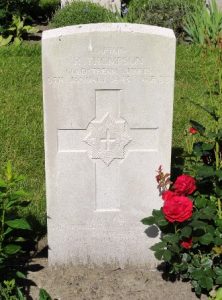
John Kinnersley Yates, Sergeant, 552001, Royal Air Force. John was the son of Percy Badham Yates and Elizabeth May Yates (nee Smith), of 9, High Street, Presteigne. He followed in his father’s footsteps in joining the Royal Air Force, and was posted out to the Far East. John was captured by the Japanese on 8 March 1942 and was taken to Java POW Camp, Indonesia. He survived over two years in captivity, but died of Beri Beri at Java POW Camp on 16 October 1944, aged 23. He is buried in Ambon War Cemetery, Indonesia.